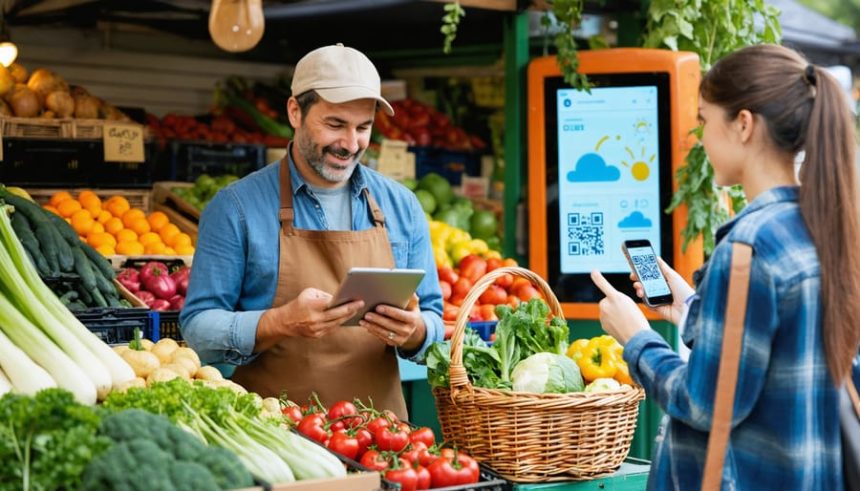Running a farmer’s market stand today means more than fresh produce and a smile—it requires operational efficiency, digital savvy, and a bit of strategic flair. While traditional tools like calculators and chalkboard signs still have their place, many successful vendors now lean on digital tools to boost visibility, streamline transactions, and create a more connected experience. Here are 6 must-have tools—and one bonus FAQ—to help your farm stand thrive.
1. Square: Seamless Payments for Stand Sales
No more “cash only” signs turning customers away. Square offers mobile point-of-sale (POS) systems that are perfect for farmer’s market vendors. The hardware is compact, and the app runs on any smartphone or tablet. What sets Square apart for vendors is its ability to handle card, tap-to-pay, and mobile wallet transactions—even offline.
Additionally, Square enables inventory tracking, tipping options, and instant digital receipts. You can also export your sales data to manage inventory trends and plan for seasonal demand. With free tools and no monthly fees (just a per-transaction cost), it’s a no-brainer.
2. Barn2Door: Direct-to-Consumer Management
Many vendors use Barn2Door to go beyond the Saturday stand. This platform lets you manage inventory, accept online orders, and even offer home delivery or curbside pickup. Its calendar features allow customers to order for specific market days—a great way to lock in sales before the weekend.
Plus, Barn2Door integrates with email marketing tools, helping you send recipes, farm stories, and “what’s in season” newsletters to keep customers engaged long after the market ends.
3. Trello: Keep Harvest and Market Prep on Track
Most farm stands are multi-hat operations—planting, harvesting, prepping, packaging, and marketing. Trello, a task management tool, is surprisingly helpful for organizing those moving parts. You can use boards to track growing seasons, market prep, team assignments, and delivery routes.
With mobile-friendly checklists and deadline reminders, Trello keeps the whole operation organized even when your hands are in the dirt. It’s also a great way to delegate tasks to family members or seasonal help.
4. Local Line: B2B Sales Made Simple
While many digital tools focus on direct-to-consumer sales, Local Line is designed for selling to restaurants, retailers, and food co-ops. If your stand regularly supplies wholesale buyers, this tool helps you manage custom pricing, recurring orders, and communication—all in one dashboard.
It also integrates with inventory and delivery tools, giving your farm stand the sophistication of a full-scale distributor without the headache.
5. Instagram Stories + Linktree: Social Presence That Converts
Social media isn’t just for branding anymore—it’s a functional sales tool. Using Instagram Stories, vendors can showcase the morning’s harvest, flash deals, or “last bundle” alerts to drive urgency. Pair that with Linktree (a free tool that turns your bio link into a mini landing page), and you have a digital storefront that leads directly to order forms, event sign-ups, or your Square store.
The key is consistency: post market locations, times, and featured items weekly. Over time, you’ll build a loyal digital following that converts into real-life foot traffic.
6. Govee Smart Sensors: Temperature Tracking for Compliance
If you’re selling eggs, dairy, or meats at the market, you likely need to maintain specific temperature ranges. Govee smart thermometers and humidity monitors are Bluetooth-enabled and come with alerts you can set for compliance thresholds. If your cooler malfunctions during a hot day, you’ll know before the product is spoiled.
This kind of monitoring builds trust with both regulators and customers—especially those who ask detailed food safety questions.
🥕 Vendor FAQ: Designing Cards That Customers Keep
As markets get busier and vendors compete for attention, many customers remember you not by what they bought—but by what you gave them to take home. Thoughtfully designed cards (greeting cards, recipe inserts, or thank-you notes) can extend your stand’s story into the customer’s kitchen or living room. Here are answers to common card design questions:
Q1: What kind of card should I give out at my booth?
A mini card with your farm name, contact info, and one personal touch—like a recipe or food storage tip—goes a long way. If you sell heirloom tomatoes, a “Fresh Tomato Salsa” card gives the purchase extra value.
Q2: Where can I design and print greeting cards for my farm stand?
Adobe Express is a great option because it allows you to print greeting cards using free, customizable templates perfect for small-batch card printing. It’s fast, intuitive, and you can include your farm’s colors and logo without needing a graphic designer.
Q3: What size card works best for handing out at a market?
4×6″ or 5×7″ are great sizes—easy to carry, large enough for legible recipes or messages, and they fit inside standard display baskets. You can stack them or tie them to product bundles with twine.
Q4: Can I include QR codes on cards?
Absolutely—and you should! Add a QR code linking to your Square checkout, newsletter signup, or online store. Use a URL shortener like Bitly to track card engagement.
Q5: Are there other platforms besides Adobe Express for card design?
Yes. Tools like Vistaprint and Moo offer easy online ordering and design templates tailored for businesses. Just make sure any design reflects your brand’s story—don’t use stock images unless they match your actual farm aesthetic.








